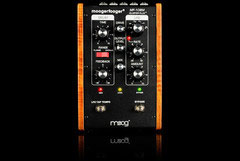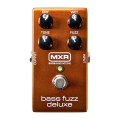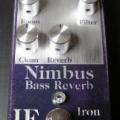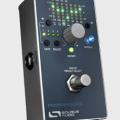 “Gently tap the wooden side pieces,” the manual says, “of your new moogerfooger to wake it up after the long journey to its new home.“ Like you’re waking a sleeping puppy you just brought home for the first time. Rather, it’s more like waking a sleeping giant. No, that’s not it…it’s like waking a massive, fire-breathing, candy-crapping dragon that won’t leave you alone. That’s right, fire…its ability will scorch your mind and potentially your speakers if you’re not careful. (The warning’s in the manual…about the speakers.) And candy…ear candy, lots of it, with the lushest chorus and flange I’ve heard in a long time. And these are good things, because you can’t put it away or put it to bed, and fortunately, you don’t have to clean up after it. You just keep toying with it, figuring out how you can wreak havoc with it next. It’s the newest in the lineup of Moogerfoogers and a blast to play with. How much fun you have or how much trouble you get into with the Moog MF-108M Cluster Flux is just a matter of time.
“Gently tap the wooden side pieces,” the manual says, “of your new moogerfooger to wake it up after the long journey to its new home.“ Like you’re waking a sleeping puppy you just brought home for the first time. Rather, it’s more like waking a sleeping giant. No, that’s not it…it’s like waking a massive, fire-breathing, candy-crapping dragon that won’t leave you alone. That’s right, fire…its ability will scorch your mind and potentially your speakers if you’re not careful. (The warning’s in the manual…about the speakers.) And candy…ear candy, lots of it, with the lushest chorus and flange I’ve heard in a long time. And these are good things, because you can’t put it away or put it to bed, and fortunately, you don’t have to clean up after it. You just keep toying with it, figuring out how you can wreak havoc with it next. It’s the newest in the lineup of Moogerfoogers and a blast to play with. How much fun you have or how much trouble you get into with the Moog MF-108M Cluster Flux is just a matter of time.
(Note:Â Whoever named this pedal should’ve gotten a bonus.)
Anyhow, it does sound amazing. Plugging in a bass and listening to the classic chorus and flanging functions, as well as some fine vibrato, gives you what you’d expect;  fat, beautiful, analog loveliness. Stereo capable too. The only rub is that it does so much more, at $599.00 list, (Bass EFX sells it cheaper,) you’ll want to utilize much more than just the chorus or flange. But that’s where the fun comes in.
The Cluster Flux is set up with two basic functions: (1)  A dual range “Bucket Brigade Device” Delay line to toggle between Chorus and Flange, set the length of Delay for each, (.6 msec to 10 msec for Flange and 5 msec to 50 msec for Chorus,) and Feedback. Boosting the Feedback in both Chorus and Flange modes will give each effect a slightly more shimmery edge. (2) A multi-waveform Low Frequency Oscillator (LFO) with six waveforms available: Sine, Triangle, Square, Sawtooth, Ramp, and Random Stepped (my favorite.) The LFO contains “Rate” and “Amount” for the frequency and overall amount of the modulation. There are additional, more basic, controls for “Drive” (gain), “Output Level”, and “Mix”.  Rounding out the panel are switches for “Bypass” and “LFO Tap Tempo”. The tap tempo is really cool for on-the-fly speed adjustment without muting the sound. Just tap the switch three times at the desired rate and it will adjust the rate on the third tap. If you goof up, you can keep tapping the switch and it’ll set a tempo based on the average of your tap speeds.
 Twiddling the knobs and switches on the MF-108M is great fun, especially because the Cluster Flux Feedback control can drive the delay line into self-oscillation, without any audio signal present. Moog gives us a word of warning here to be careful with your ears and your speakers as the self-oscillating signal can be much stronger than normal signal levels. Here, I actually introduced a signal from my bass and was able to unplug it, put it on the stand, and geek out for a bit. This makes for creating everything from siren-like sounds to laser blasts to rather musical arpeggiating in the random wave mode. It can be unwieldy, but you expect this and learn to control it. All this can be rather difficult to accomplish live, especially with a bass on your shoulders, so the MF-108M’s Feedback, Time, LFO Rate, LFO Amount, and Mix are all voltage controllable. This means you can use expression pedals along with 1/4″ TRS cables, a MIDI-to-CV converter, or any other voltage control to change the parameters of the Cluster Flux. This also means that you can use other Moogerfoogers to control the Cluster Flux or each other, for that matter. Larger pedal board? Hell yeah!
Twiddling the knobs and switches on the MF-108M is great fun, especially because the Cluster Flux Feedback control can drive the delay line into self-oscillation, without any audio signal present. Moog gives us a word of warning here to be careful with your ears and your speakers as the self-oscillating signal can be much stronger than normal signal levels. Here, I actually introduced a signal from my bass and was able to unplug it, put it on the stand, and geek out for a bit. This makes for creating everything from siren-like sounds to laser blasts to rather musical arpeggiating in the random wave mode. It can be unwieldy, but you expect this and learn to control it. All this can be rather difficult to accomplish live, especially with a bass on your shoulders, so the MF-108M’s Feedback, Time, LFO Rate, LFO Amount, and Mix are all voltage controllable. This means you can use expression pedals along with 1/4″ TRS cables, a MIDI-to-CV converter, or any other voltage control to change the parameters of the Cluster Flux. This also means that you can use other Moogerfoogers to control the Cluster Flux or each other, for that matter. Larger pedal board? Hell yeah!
And for those of you doing double duty with a Key Bass, Bass Synth, or Keyboard parts, the MF-108M is MIDI capable via the MIDI channel. The settings for front and rear panels as well as Clock Divisions for rhythmic variations are all set with MIDI Control Change (CC) Messages that you program with whatever MIDI controller you’re using.
Lastly, you have a nice degree of control over the output configuration for recording, live sound, or routing through different backline amps. An array of six internal dip switches lets you optimize the output for “Right Output”, “Mix”, “Wet” and “Dry” signals, and whether you want the signal in or out of phase.
The Moog MF-108M is a brilliant analog chorus, flanger, and vibrato pedal.  Arguably, the best. In that controlled environment, it’s a beautiful creature that you’ll be comfortable with. That, however, is the stepping off point and this review fundamentally addresses its full potential. You really need to spend time, (and therefore the ducats,) to grasp what it will do for you in your creative process. It’s endless. And at its price point, you’ll want to let the dragon off the leash for full performance and effect. In King Lear, Shakespeare warned, “Come not between the dragon and his wrath.”  Well, the wrath of the Moog MF-108M Cluster Flux needs to be embraced then turned loose.  Just watch your speakers.
Buy a Moog Product and receive a free Bass EFX t-shirt, free shipping in the U.S., and a free set of DR nickel strings (.45-.105) I’ll work out the shirt size with you after your order is placed. Offer ends May 31, 2012.
About the author:
“I created BassEfx.com because the bass community clearly needed a place that would consolidate all the best effects pedals in one place. BassEfx.com gives bass players – and only bass players – a resource that showcases what’s available, offers the best advice and gets you the right effect. My background: I co-founded Bass Northwest, the world’s largest bass-only retail operation, and ran it for 15 years, (1994-2009.) In 30 years as a bass player, I’ve seen, heard, and played just about every amplifier, bass, cabinet and effect pedal imaginable.â€




